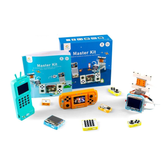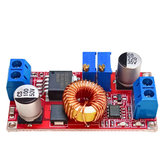-
LM2596 DC-DC Buck Converter Adjustable Step Down Power Supply ModuleLM2596 DC-DC Buck Module The LM2596 DC-DC Buck Converter Step-Down Power Supply Module is a step-down(buck) switching regulator, capable of driving a 3-A load with excellent line and load regulation. These devices are available in fixed output voltages of 3.3V, 5V, 12V, and an adjustable...
- Rs. 40
Rs. 64- Rs. 40
- Unit price
- per
Save Rs. 24 -
MT3608 DC-DC Boost Module (2V-24V)MT3608 DC-DC Boost Module (2V-24V) The MT3608 2A Max DC-DC Step Up Power Module Booster Power Module is a budget-friendly module that enables the user to step-up a 2 to 24V input voltage to a 5 to 28V output at a maximum of 2A....
- Rs. 33
Rs. 44- Rs. 33
- Unit price
- per
Save Rs. 11 -
XL4015 5A Constant Current/Voltage LED Drives Lithium Battery Charging ModuleXL4015 5A Constant Current/Voltage LED Drives Lithium Battery Charging Module This versatile Buck converter serves as a standard step-down module equipped with overcurrent protection for a variety of applications. It functions as a charging device for lithium, nickel-cadmium, and nickel-hydrogen batteries, as well as...
- Rs. 113
Rs. 199- Rs. 113
- Unit price
- per
Save Rs. 86 -
AMS1117 5V Step-Down Power Supply ModuleAMS1117 5V Step-Down Power Supply Module This Step-Down power supply module (buck converter) utilizes the AMS1117 5V regulator to regulate input voltage in the range of 6.0 to 12V down to a fixed 5V output at a maximum of 1A. The input and output...
- Rs. 19
Rs. 29- Rs. 19
- Unit price
- per
Save Rs. 10 -
XL6009 Boost ModuleXL6009 Boost Module The XL6009 Step Up module is one of the widely used modules, where there is a requirement of having a specific fixed output voltage, even when the input voltage is below or above the required output voltage. XL6009 module is a...
- Rs. 54
Rs. 69- Rs. 54
- Unit price
- per
Save Rs. 15 -
LM2596 DC-DC Step-down Buck Module with DisplayLM2596 DC-DC Step-down Buck Module with Display The LM2596 Step Down Module with LED Display, is a versatile and compact solution for your power needs. This adjustable buck converter allows you to regulate voltage between 1.25V to 37V with a maximum output current of...
- Rs. 114
Rs. 199- Rs. 114
- Unit price
- per
Save Rs. 85 -
XL4015 DC-DC Step Down Adjustable Power Supply ModuleXL4015 DC-DC Step Down Adjustable Power Supply Module The XL4015 power module is a DC to DC step-down (BUCK) power module that operates at a switching frequency of 180kHz. In such high frequency, it provides smaller-sized filter components compared with low frequency switching regulators. This DC-DC...
- Rs. 71
Rs. 144- Rs. 71
- Unit price
- per
Save Rs. 73 -
MP1584EN Mini LM2596 ultra-small DC-DC step-downMP1584EN Mini LM2596 ultra-small DC-DC step-down The MP1584 is a high frequency step-down switching regulator with an integrated internal high-side high voltage power MOSFET. It provides 3A output with current mode control for fast loop response and easy compensation. DC-DC step-down (buck converter) module is...
- Rs. 45
Rs. 64- Rs. 45
- Unit price
- per
Save Rs. 19 -
400kV High Voltage Generator 3-6V DC High Voltage Pulse Generator400kV High Voltage Generator 3-6V DC High Voltage Pulse Generator The 400kV High Voltage Generator offers reliable and powerful performance for your electrical projects. This 3-6v DC pulse generator is ideal for use in automotive, communication, medical or industrial applications that require high voltage...
- Rs. 99
Rs. 199- Rs. 99
- Unit price
- per
Save Rs. 100 -
DC-DC SX1308 Step-up Adjustable Power ModuleDC-DC SX1308 Step-up Adjustable Power Module The SX1308 Adjustable Power Supply is a DC-DC step-up module that has a maximum output power of 28V and 2A, utilizing a 1.2Mhz power booster module with an SX1308 chip. The SX1308 chip comes in a small package...
- Rs. 34
Rs. 49- Rs. 34
- Unit price
- per
Save Rs. 15 -
12A 300W DC-DC Buck Converter Step down Power Module 7-32V to 0.8-28V12A 300W DC-DC Buck Converter Step down Power Module 7-32V to 0.8-28V The 12A 300W DC-DC Buck Converter is a step-down power module that adjusts input voltage from 7-32V to an output of 0.8-28V. It has large aluminium heat sinks for better cooling and...
- Rs. 229
Rs. 399- Rs. 229
- Unit price
- per
Save Rs. 170 -
XL6019 DC-DC 5A Adjustable Boost Power Supply Module (RED)XL6019 DC-DC 5A Adjustable Boost Power Supply Module(RED) DC to DC step up module based on the upgraded XL-Semi XL-6019, offering up to 5A switching current and conversion efficiency of up to 97%. This XL6019 boost converter has two input pins for VCC and...
- Rs. 130
Rs. 199- Rs. 130
- Unit price
- per
Save Rs. 69 -
2A Step-up MT3608 2V-24V DC-DC Boost Converter Module with Micro USB Port2A Step-up MT3608 2V-24V DC-DC Boost Converter Module with Micro USB Port The 2A Step-up MT3608 DC-DC Boost Converter Module is a compact and efficient power conversion solution designed to step up the voltage from 2V-24V to a higher voltage, such as 9V, 12V, 15V,...
- Rs. 39
Rs. 44- Rs. 39
- Unit price
- per
Save Rs. 5 -
150W Dc-Dc Boost Adjustable Power Converter150W Dc-Dc Boost Adjustable Power Converter This DC-DC boost power supply/converter module is incredibly versatile, capable of stepping up any input voltage from 10V to 32V to an output voltage ranging from 12V to 35V. It can produce up to 150W of output power...
- Rs. 149
Rs. 208- Rs. 149
- Unit price
- per
Save Rs. 59 -
0.9V-5V to 5V 600MA USB Output charger step up Mini DC-DC Boost Converter0.9V-5V to 5V 600MA USB Output charger step up Mini DC-DC Boost Converter This Step-up Module is highly beneficial as it allows for an input range of 0.9-5V and an output of 5V, which is compatible with a variety of digital devices. As a...
- Rs. 41
Rs. 44- Rs. 41
- Unit price
- per
Save Rs. 3 -
XL6019 DC-DC 5A Adjustable Boost Power Supply ModuleXL6019 DC-DC 5A Adjustable Boost Power Supply Module DC to DC step up module based on the upgraded XL-Semi XL-6019, offering up to 5A switching current and conversion efficiency of up to 97%. This XL6019 boost converter has two input pins for VCC and...
- Rs. 159
Rs. 168- Rs. 159
- Unit price
- per
Save Rs. 9 -
LM2596 Mini 360 Power Supply Step-down ModuleLM2596 Mini 360 Power Supply Step-down Module This product DC-DC step-down module can be used as DIY mobile power, monitor power supply, car power, camera power supply, communications equipment supply, the various right size, and weight for demanding applications. Mini 360 Step-Down Buck Converter...
- Rs. 39
Rs. 59- Rs. 39
- Unit price
- per
Save Rs. 20 -
XL4016E1 DC 4-40V to DC 1.25-36V 8A Buck Converter Voltage Regulator 36V 24V 12V to 5VXL4016E1 DC 4-40V to DC 1.25-36V 8A Buck Converter Voltage Regulator 36V 24V 12V to 5V The XL4016 is a type of power converter that can lower the voltage efficiently and smoothly. It can handle a load of up to 12 amps and has...
- Rs. 175
Rs. 249- Rs. 175
- Unit price
- per
Save Rs. 74 -
LM317 DC to DC Converter Step Down Power SupplyLM317 DC to DC Converter Step Down Power Supply The LM317 DC-DC converter is a crucial electronic circuit used to lower a DC source voltage from one level to another. It finds significance in portable electronic devices like laptops and cell phones that primarily...
- Rs. 54
Rs. 99- Rs. 54
- Unit price
- per
Save Rs. 45 -
LM2596S & LM2577S DC-DC Adjustable Step-Up and step-down Power Supply ModuleLM2596S & LM2577S DC-DC Adjustable Step-Up and step-down Power Supply Module This is a buck-boost converter with an output voltage greater or less than the input voltage. Compared to linear regulators, DC/DC converters are primarily focused on efficiency and can achieve efficiencies of over...
- Rs. 269
Rs. 371- Rs. 269
- Unit price
- per
Save Rs. 102

Best Price Guarantee

Ready Stock for Bulk Purchase

Dedicated Account Managers

5% GST Benefits for Eligible SEZ and Edu

Technical Support Available

1-Year Manufacturer Warranty





















































